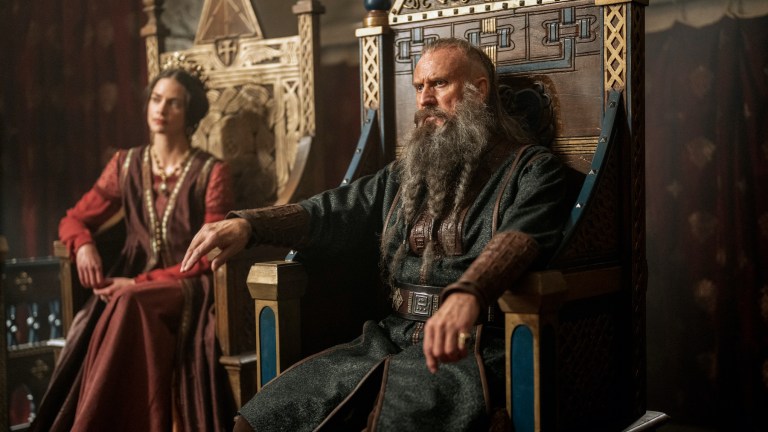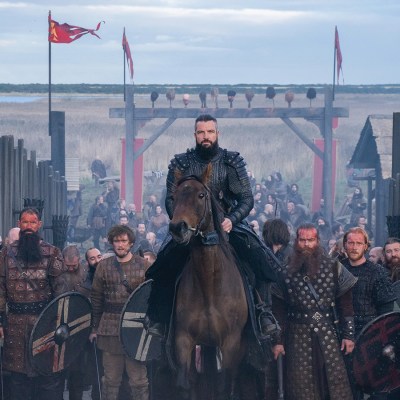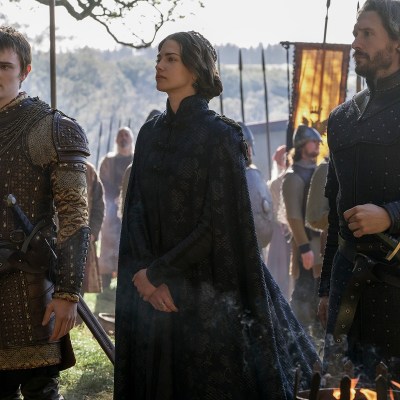Vikings: Valhalla Ending Explained
With King Canute away at war, Queen Emma calls on her friends to defend the English kingdom in the Vikings: Valhalla season finale.

This Vikings: Valhalla article contains spoilers.
“You have gambled much on the whims of a crazy man.”
Though Christian zealot Käre might disagree, everything comes to a head in the Vikings: Valhalla season one finale, and “The End of the Beginning” employs its elegantly constructed battle sequences to tie up a few dangling plot threads and propel three survivors on to the next stages of their lives. Though Liv dies valiantly defending Kattegat against Olaf’s sinister plot, we now look to Freydis, Leif, and Harald to move on amidst an ever evolving political landscape which includes England’s Queen Emma after she successfully executes a brilliantly laid trap for the Danish interloper Queen Aelfgifu. And yet again, Godwin finds himself on the winning side.
Once more Kattegat finds itself at the epicenter of the narrative, and while it may be somewhat foolish to even consider individual stakes in a historical drama, it’s easy to get lost in the physical and interpersonal actions. Perhaps it’s the Vikings afterglow, but the emotional centerpiece of the series still revolves around Freydis, Leif, and Harald. And while the English story remains historically significant, and Canute and Emma an extremely compelling and engaging couple, our roots remain in the village that Ragnar and Lagertha raised to prominence. Are the Vikings the “good guys” in this narrative, simply trying as best they can to hold on to their cherished beliefs against the often relentless pursuit at the hands of Christian fanatics like Käre? Christians like Harald Sigurdsson and Queen Emma of Normandy remind us that there is room for compromise and mutual understanding.
Are Odin and the Old Gods Doomed?
It’s probably unfair to say that “The End of the Beginning” takes Vikings: Valhalla back to its roots with its grand scale battle sequences that thrive on putting the visceral nature of war on open display, because political and familial intrigue remain just as important and just as prominent here. That said, the tension we experience in Kattegat as Jarl Hakkon prepares for the coming onslaught leads almost seamlessly into one of the last vestiges of their pagan beliefs. She gathers the troops in the main hall and passionately acknowledges the need for Odin and the gods to aid in the fight against the Christians, and suddenly it becomes clear that Audun has willingly offered himself as a human sacrifice.
While the recognition of what’s about to occur is horrific enough, and though we’ve experienced similar acts in Vikings, watching the priestess drink the young man’s blood forces the viewer into a minor Sophie’s Choice scenario. Do we back Olaf and Käre’s ethnic cleansing approach or a religion that finds it perfectly acceptable to carry out ritual killings in the name of Odin?
As Greenlanders, Leif and Freydis have been presented not only as outsiders, but as less sophisticated and worldly when placed up against the residents of Kattegat. Despite their allegiance to Odin and the gods, they don’t appear totally on board with the human sacrifice, and we have to wonder whether this is something that’s outside of their world view.
Has Harald Really Changed Sides?
One of the more interesting angles of the Kattegat story centers around Harald’s floating allegiance, and while we’re disappointed when it appears he’s gone over to the dark side, it’s not completely surprising that he sides with his Christian brothers. However, it’s equally unsurprising that he’s not only attempting to manipulate the action but gathering intel to be surreptitiously passed on to Leif during the parley that he suggests take place. It’s a brilliant strategy, but unfortunately, his half-brother Olaf is more astute than perhaps we give him credit for. Nevertheless, it’s the still developing connection between Harald and Leif that drives the scene when his words to Leif provide critical battle plan details. “You’ve made your case. Now return to your madman,” Leif tells his friend, and we’re left to wonder whether this knowledge will save Kattegat.
Leif quickly realizes they’ve been outmaneuvered by Olaf, and it doesn’t take long to realize that Kattegat is about to fall to the Christian horde. Watching Hakkon fall to Christian arrows and then be carried off by four of her shieldmaidens signals what appears to be Kattegat’s last gasp as an outpost of Odin’s followers. Of course, Olaf’s victory is short lived, and we get a great image of his men fleeing the great hall, and him alone, gazing at the empty throne that will not be his after all.
What’s Next for Freydis and Leif?
The assault on Kattegat also produces a number of subplots, not the least of which is Liv’s death and the emotional scar it leaves on Leif. Sam Corlett’s gut wrenching performance as Leif fights off six of Olaf’s men intent on raping an innocent woman, stands as the series’ most powerful character work. He bludgeons the last man and the visual of Leif covered in the blood of the men he’s just killed, an ax in each hand, leaves us to wonder how he’ll recover from this emotionally devastating experience.
Historically, speaking, we’re fairly certain Leif will survive this battle, and without consulting online sources, the same goes for Freydis. So when we finally get to see her face Käre one-on-one, it seems obvious she’ll survive somehow. Still, it’s a terrifically choreographed sequence in which Freydis holds her own for a time until he finally takes her sword and begins kicking her beaten and bruised body as she crawls along the floor. And then Käre falls prey to one of television drama’s oldest tropes. Instead of simply killing his opponent as soon as the opportunity arises, he delays and ends up giving Freydis the opportunity to snatch victory from the hands of defeat. Of course, we’re delighted she survives and viewers give a fist pump when she produces the hidden dagger and then drives it into his chest, but it’s become a tired narrative device we see far too often.
Though Freydis rides off with the wounded Harald, it seems a foregone conclusion they’ll eventually reunite with Leif, though their paths may take some time to coincide. Will they encounter Forkbeard now that he’s sailed into Kattegat and will presumably run Olaf’s troops off into the countryside? Who will take charge of one of Norway’s most important port cities now that Hakkon is dead?
Two Queens Enter, One Queen Stays
Unquestionably, there are a number of great scenes in the finale, but none more gratifying than watching Queen Aelfgifu enter the throne room full of bravado only to find Emma sitting on the throne. The intricate ruse allows Forkbeard time to find his fleet which he then sails to Kattegat, but it’s Godwin’s role that complicates our understanding of how things will turn out in the English court.
“You are a queen, Your Highness. Just not England’s queen,” he glibly tells the deflated Aelfgifu. Now it’s up to Emma to remain in control with both Canute and Forkbear away from the kingdom, but I think we know she’s up to the task.
Vikings: Valhalla concludes its inaugural season with the political and religious landscapes in flux, but there’s no doubt the series is firing on all cylinders. “The End of the Beginning” returns a sense of normalcy in England as Emma awaits Canute’s return, but we know to keep a suspicious eye on the ever-plotting Godwin. Our Vikings roots run deep, however, and concern for the Greenlanders and Harald remains on high alert.

